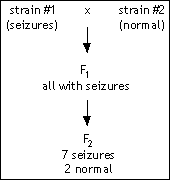 You are studying seizures using a mouse model. You have a true-breeding strain of mice that has frequent, spontaneous seizures. You cross these to another true-breeding strain that does not have seizures. The F1 all have seizures, and a single mating of two F1 animals produces 2 normal mice and 7 mice with seizures.
You are studying seizures using a mouse model. You have a true-breeding strain of mice that has frequent, spontaneous seizures. You cross these to another true-breeding strain that does not have seizures. The F1 all have seizures, and a single mating of two F1 animals produces 2 normal mice and 7 mice with seizures.
 The Great Northwestern Dragonfly develops in a manner similar to Drosophila , with the following difference: while Drosophila has one set of wings and one set of halteres (flight balancers) in the segment immediately posterior to the wing segment, the dragonfly has two sets of wings. The dragonfly larva has seven segments, shown here with their future adult fates.
The Great Northwestern Dragonfly develops in a manner similar to Drosophila , with the following difference: while Drosophila has one set of wings and one set of halteres (flight balancers) in the segment immediately posterior to the wing segment, the dragonfly has two sets of wings. The dragonfly larva has seven segments, shown here with their future adult fates.